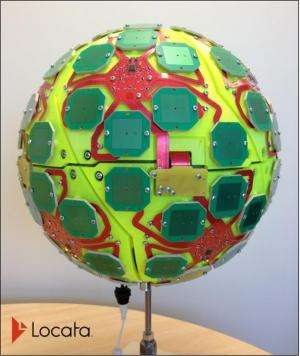September 25, 2013 weblog
Air Force school looks to Locata GPS antenna technology

(Phys.org) —The Air Force Institute of Technology, or AFIT, is the Air Force's graduate school of engineering and management as well as its institution for technical professional continuing education. Earlier this month, AFIT and Locata, based in Canberra, Australia, announced an R&D deal to build and demonstrate new Locata multipath mitigation technology for use in GPS receivers. Locata, which also has an office in Las Vegas, has attracted interest within and beyond the Air Force for advancements made in global positioning system receivers. "This cooperation is expected to leverage many years of proprietary Locata ground-based technology development to bring completely new capabilities to satellite-based GPS receivers," said the AFIT announcement.
AFIT is looking to develop GPS-specific versions of Locata's correlator and switching algorithms. Locata has attracted general interest in its VRay, an invention of Locata co-founder David Small. This is a type of antenna that can eliminate multipath interference. This says a lot for the frustrated many who have come to realize that GPS does not guarantee precision in urban areas. The VRay has been purposed for better performance in difficult environments.
The VRay uses a beam-forming antenna with receiving elements that identify and subtract multipath and other interference to extract a clean signal. The antenna scans for beams and distinguishes what GPS signal is valid. The VRay has been designed for use on automated industrial and warehouse equipment, such as forklifts. but the antennas are under development for other form factors including smaller devices.
GPS has presented some difficulties in places where tall buildings in urban areas interfere with signals. Those familiar with the problem cite multipath interference as the hurdle, as satellite signals reflect off buildings and confuse the positioning systems. That is where VRay is said to come in, serving areas where multipath has made it almost impossible for other RF-based positioning technologies to work.VRay technology delivers the needed accuracy and reliability in those instances. A New Scientist report on Locata's technology quoted consultant David Last, former president of the UK's Royal Institute of Navigation, assessing the value of Locata's technology. "The concept of beam-steering for GPS is well known. However, its use has been mainly confined to the military due to the high cost. Locata's breakthrough is to time-multiplex the receiver," he said.
The basketball-sized VRay prototypes are still bulky for some of newer applications in mind but designs under discussion include antennas that are flush with airframes and vehicle roofs, and a version built into helmets. Locata was incorporated in 1997 by David Small and Nunzio Gambale.
More information:
www.insidegnss.com/node/3724
www.afit.edu/PA/news.cfm?article=588&a=news
www.locata.com/
© 2013 Phys.org


















